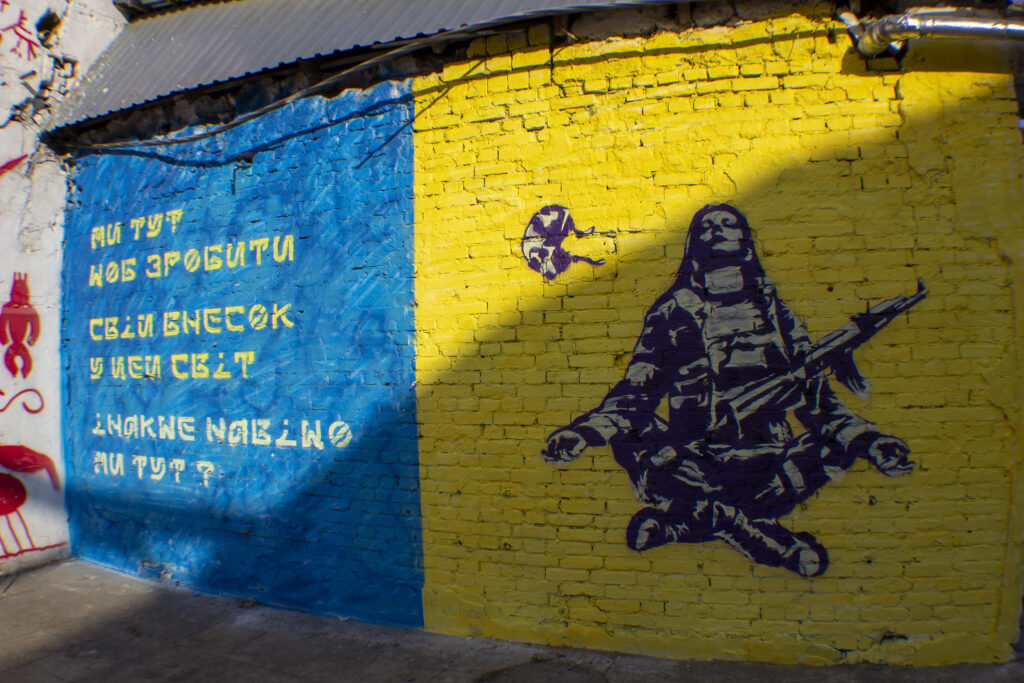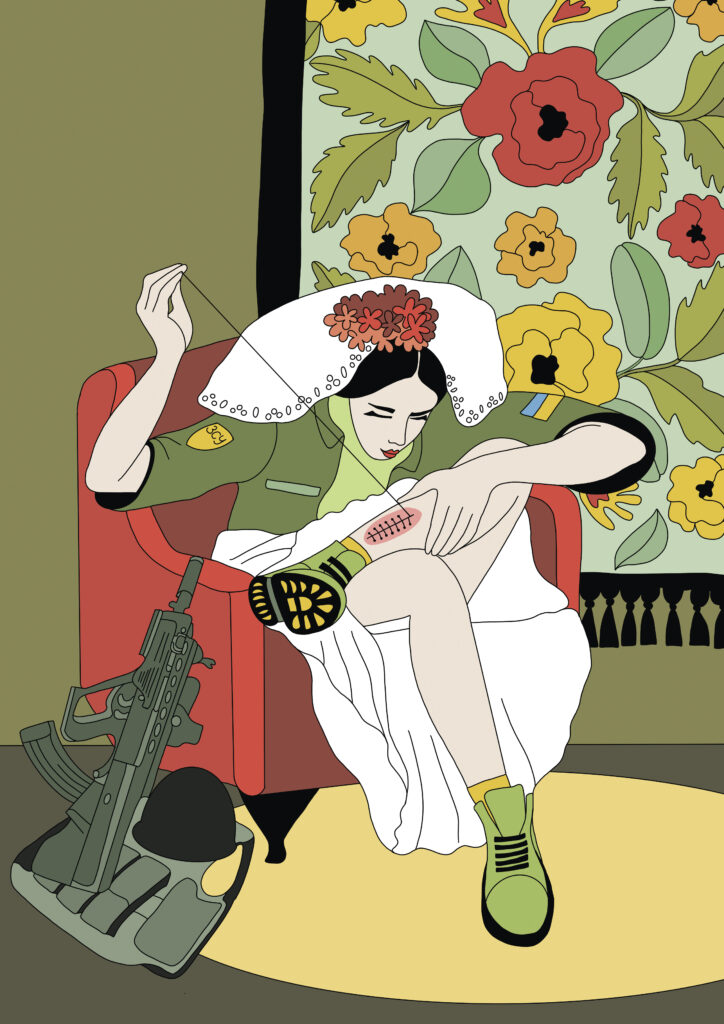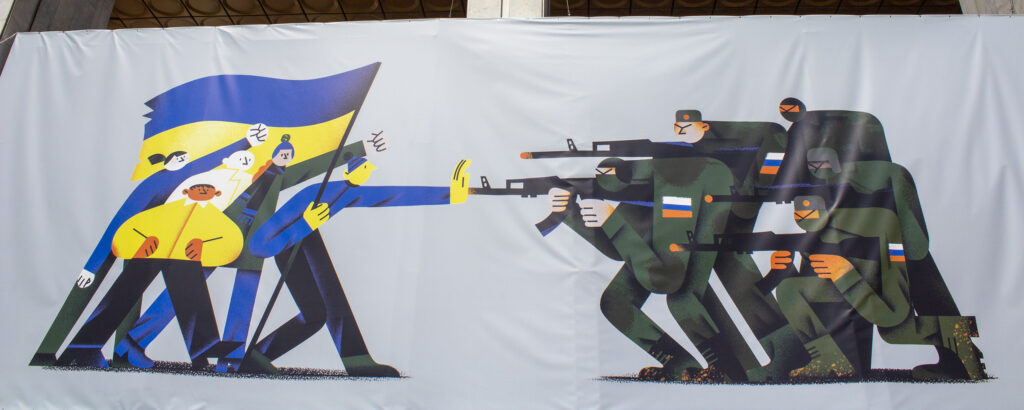Art books can be beautiful but often I get a gradual sense of boredom as I turn from one perfect image to another. Too much art, beauty and perfection can be overwhelming.
I don’t like the way art is presented. What bugs me are those convoluted, oh-so-clever texts that are displayed as you walk into exhibitions; texts that are often so full of obscure words that often I think you need to study art at university in order to understand the gobbledegook that curators sometimes write.
Daoud Sarhandi-Williams, the editor and designer, has avoided these linguistic problems in his latest book — Ukraine at War, Street Art, Posters + Poetry. His descriptions of the street art that he photographed in wartime Kyiv are clear and simple. He guides us through 300 pages of Ukrainian street art — some traditional, some modern — like a friendly local, guiding me (or you) through the medieval backstreets of an ancient Italian city; sharing a deeply personal and light-hearted commentary that’s so much more gratifying than the spiel the official tour guide says every day to the latest batch of tourists.

Since visiting Zaporizhzhia last summer, where I worked as a volunteer, I’ve read several books on Ukraine. The only one I’d recommend is called In Wartime; Stories from Ukraine by Tim Judah. One is a novel called Death and the Penguin by Ukraine’s most famous novelist, Andrey Kurkov. Apparently it’s quite a famous tome among the literati but I found it glum and disappointing. It has black humour in spades but none of the sparkles of joy and humour that can be found in the works of the great Ukrainian-born author, Mikhail Bulgakov, a master of black humour and author of The Master and Margarita.
But I shouldn’t be too harsh on Andrey Kurkov as he did write an excellent foreword for this wonderful book I’m reviewing. Here’s an extract: “Ukraine at War: Street Art, Posters + Poetry will guide you through today’s Ukraine more honestly than any future history might…What this book shows is the restorative power of art in a time of war…Art let’s us look at today’s pain from the viewpoint of the future, so there can be a future.”
It’s not just the images that make this book worth reading. The concise words that accompany the street art transform it into a great book. I don’t think I’ve ever seen an art book like this, with such a subtle written guide easing us through the images, and the tragic modern history of Ukraine. How did this come about? Why isn’t it presented like every other art book — just image after image but no narrative to pull us along.
To answer that question we need to look to the author, an old friend I used to work with in Bosnia: Daoud Sarhandi-Williams. Daoud trained as a film editor at the BBC in London during the late 1980s, when the BBC had a lot more creative freedom than it does now. You might be wondering “What’s this got to do with it?” My answer is “everything”, as he not only wrote the text for this book, he also did the graphic design. (The book was published by Interlink in the USA and is distributed globally by Simon and Schuster).
Daoud’s method is to put together art books in the same way he’d put together a film: selecting images and words that create tension, make highs and lows, and drive the narrative forward. And it works, just as a good film will keep you glued to the screen for two hours. I was pulled through the pages of the book as if by a string.
The bulk of the book covers issues like historic statues being covered with sandbags to protect them against Russian bombs (an image of Dante’s indignant face, peeping out from a pile of sandbags, pops into mind), modern street art and graffiti, traditional Ukrainian folk-art being adapted to a modern setting (like painting flowers on tank traps); a massive display of captured Russian tanks on show in Kyiv’s main boulevard in the summer of 2022, anti-war graphics; and, the most beautiful chapter “Murals, Murals Everywhere” which consists of massive paintings covering the sides of entire blocks of flats. To my surprise, few of these murals show images of war, they tend to portray people, nature and beautiful images from the artist’s fantasy. There’s a lot of children in the book, making their own art and sometimes selling it, and plenty of flowers which are, the author writes, “cherished in Ukraine.” There are photos of people celebrating, having a good time, proving that life goes on despite the war.

If there is a message in this book it is that artists, and presumably the people of Ukraine, don’t want to dwell on the horrors that the Russian Empire has inflicted on them; they want to celebrate their independence, their freedom, and their ancient culture. A deeper message that I picked up is that the Ukrainian people will never give up. Now they’ve got their independence from the Russian tyrant, there is no way they’ll give it up. Some Western pundits say “If Trump gets in the war is over!” But I don’t buy that line. I’m sure they will fight on, just as the Bosnians did when they were invaded by the much-more-powerful Serbian army and despite the fact they were denied Western arms to defend themselves.
The Museum Blues
By now your attention may be flagging, you may have reached the point that I call “Museum Blues” — when the exhibition, or art book (or this article), has overwhelmed you. When this happens to me, as it often does, in museums and galleries, I feel exhausted.
At this point in the Ukraine book Daoud, the film editor, makes his move. He changes the pace and retains our attention as only the best films succeed in doing.
For me, the chapter on murals was the high point and I needed a break. I was also wondering “How are they made?” Like a butler who anticipates his master’s every need, Daoud plunges the reader into two chapters that give a different perspective: he tells the story of how a group of artists paint a massive mural of “the ghost of Kyiv”, a heroic pilot who stood up to the Russian Air Force when they tried to capture Kyiv in early 2022. The next chapter is a documentary-style presentation of a group of graffiti artists who use their skills to paint camouflage on vehicles which have been donated to the war effort. These chapters are the equivalent of the “making of” documentaries that sometimes accompany films.
Most books of this nature, and most films for that matter, end with a slight sense of disappointment. But Daoud Sarhandi-Williams knows that he must end with a bang. Endings are really important for filmmakers but, I suspect, they’re not for those who make art books. The concluding chapter is titled “To End a Book: In Conclusion”, and it’s a play on the title of a book called To End a War, by Richard Holbrooke, the US Diplomat who coordinated the ending of the Bosnian War in a way that didn’t resolve anything and now, thirty years later, Bosnia is still stuck economically and politically. Holbrooke’s mistake was to award the Serb aggressors with 49% of Bosnia’s territory and force this “solution” on the Bosnians. Subsequently, the same Serbs who ran a war of genocide against their neighbours then set up a racially pure Serbian mini-state within the current nation of Bosnia Herzegovina. What could possibly go wrong?
I agree totally with what Daoud writes in the conclusion: “Russia must be vanquished before any meaningful diplomacy can begin– lest it ends up with a Bosnia-style lethal peace deal. Ukraine fights on with awe-inspiring courage. This quality extends throughout the population…Such bravery and resilience — as well as faith in the power of art — still has the capacity to surprise us. As T.P. Cameron wrote in the trenches of the First World War:
Two things have altered not
Since first the world began
The beauty of the wild green earth
And the bravery of man.
From Magpies in Picardy, published posthumously in 1919.”
N.B. I had no intention of writing a review of Daoud’s Ukraine book as I’d seen it in proof form (I helped in various small ways) and rarely write book reviews. But when I read through the hardback version I released it was quite different, and much better, than the version I’d seen on my screen. It’s a gripping and fascinating insight into a country that is managing to stand up to the world’s biggest bully. It’s also a surprising book in that I had no idea such great street art was being produced in Ukraine, that the local authorities encourage it, and this work may well be the testament to Ukraine’s indomitable spirit, in the future, when they finally break the grip of Russia’s rotten empire.
Ukraine at War, Street Art, Posters + Poetry, by Daoud Sarhandi-Willians, was published in 2023 by Interlink Books. You can get a copy from the publisher here or from Amazon here.
All the photos in this article were taken by the author/designer: Daoud Sarhandi-Williams.

- Introduction to 12 Jobs in 12 Months - April 23, 2024
- Why am I writing a Book About 12 Jobs in 12 Months? - April 4, 2024
- A Guide to Ukraine’s Future - February 19, 2024



An excellent, informative review which seems to do justice to a series of people doing important work.
The more we pay attention to all aspects of what is at stake in Russia, the better.
Thanks Rupert.
I was not aware of this book so thank you for bringing it to my attention with such a detailed and insightful review. The pictures you selected are particularly striking and the imagery you paint with your words are simply on point.
I loved the image of being pulled as with a string throughout the book. It resonates with a Romanian idiom (ma trage ata) and shows the author achieved what they set off: fascinate and pull the audience into the streets of Ukraine. I hope people will come and rebuild once victory is assured.
Slava Ukraina! And thank you, Rupert and Daoud.
Fascinating detail about what a lot of commentators mention about Ukrainian people: their indomitable spirit. It sounds like an important record of this moment in time which I hope will get a wider audience.
The question is: is it available in all good bookshops where art books can do really well. I thought that the publishers, Interlink, were American? Is there a European publisher that can manage distribution?
I put these points to the author/designer, Daoud Sarhandi Williams, and he sent me this reply by WhatsApp:
“Simon and Schuster are a global distributor working on behalf of Interlink, in this case. And they have reps all over the world that offer the books to bookshops. In the UK it’s in Blackwells, Foyles etc…
“I can see there are various booksellers selling it in Denmark, Holland, Portugal, Poland, etc. So it’s getting around. Time will tell.”
As the author of Ukraine at War, I would like to thank Rupert for this glowing review. Rupert helped me a lot with planning my trip and reading proofs at various stages. But after his last reading I rewrote a lot, added many pages, and reshaped the book considerably– and so I guess he came to the book relatively fresh.
Ukraine at War also took longer than imagined to get to press. (I would have liked it to appear sooner.)
Rupert has understood the book exceptionally well, I see! Not only its form, but the tone, and contents, too. I am pleased he has read it so closely, and I am aware that the “problem” with art books generally is that people buy them, look at them, but don’t often read them in detail and linearly. Perhaps they don’t precisely because, as Rupert points out, such books are frequently pretentious and elitist; I also find that the case all too often. I am pleased I have avoided that trap, since Ukraine is an issue we all need to understand — and urgently.
The war in Ukraine, and Russia’s essentially imperialist ambitions, is reshaping the world we live in — and may do so even more in the coming months and years.
Thank you for taking the time to help us navigate and understand the richness of this book, and inspiring me to read it. Not just enjoying the images but to read it as well, rather than avoid reading the small print which I often find tedious and irrelevant in art spaces. Your knowledge is always impressive.